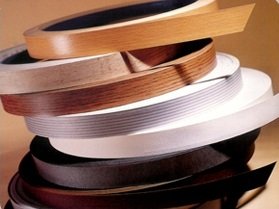Edge Banding คือ อะไร
Last updated: 26 มี.ค. 2562 | 4342 จำนวนผู้เข้าชม |

Edge Banding, or edgebanding, is the name of both a process and an associated narrow strip of material used to create durable and aesthetically pleasing trim edges during finish carpentry.
Edge banding is used to cover the exposed sides of materials such as plywood, particle board or MDF, increasing durability and giving the appearance of a solid or more valuable material. Common substitutes for edgebanding include face frames or molding. Edge banding can be made of different materials including PVC, ABS, acrylic, melamine, wood or wood veneer.
Traditional edge banding was a manual process requiring ordinary carpentry tools and materials. In modern applications, particularly for high-volume, repetitive manufacturing steps such as cabinet doors, edge banding is applied to the substrate by an automated process using a hot melt adhesive. Hot melt adhesives can be water or solvent based and may consists of various raw materials including EVA, PUR, PA, APOA, and PO. A substrate primer may also be used as a bonding agent between the adhesive and the substrate. Thicker edge bandings typically require a slight concavity to provide a tight glue line. The thickness can vary from .018″ to 5mm or even more. The machine that applies the edge banding is called edgebander. An edgebander bonds the edge banding to the substrate, trims the leading and trailing edges, trims top and bottom flush with the substrate, scraps any surplus, and buffs the finished edge.
เนื้อหาที่เกี่ยวข้อง
ทางเลือกในการซื้อพื้นไม้
19 มี.ค. 2562
วิธีการใช้งานไม้ปาร์ติเกิลเคลือบเมลามีน
26 มี.ค. 2562
ไม้กันชื้น คืออะไร?
26 มี.ค. 2562
ประเภทไม้
26 มี.ค. 2562



